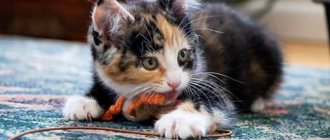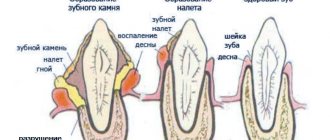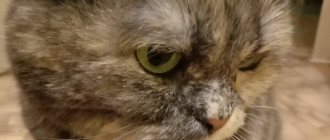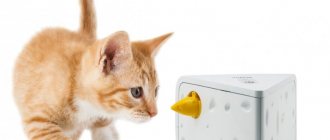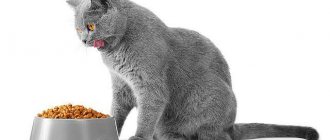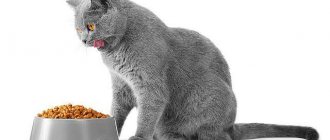Cats teeth
In most cases, kittens are born without teeth. There are exceptions to this rule, but they are extremely rare. At the age of 4-5 weeks, the kitten begins to cut its first teeth. The first set consists of 26 pieces (14 on the upper jaw and 12 on the lower jaw). As a rule, by two months the growth process is completed. By this time, healthy young cats can feed themselves and can be given solid food. They can also suckle from a cat; this usually does not cause discomfort to mothers.
Milk teeth are covered with white enamel, they themselves are sharp and quite thin. There are six incisors on the front of the jaws, followed by canines - one on each side. After them, premolars and molars grow, three on the lower jaw and two on the upper. The sequence of eruption is as follows: first the incisors appear, then the canines, and then the molars.
When the process of growth of the first, milk teeth is completed, the kittens are sent to a new place of residence (if the owner intends to do so). Before this, the first vaccinations are given and the necessary documents are completed.
It is necessary to sell or give away a kitten before the change of milk teeth to permanent ones begins.
Moving is stressful for an animal, and, in addition, during the process of replacing teeth, its body is weakened, so it is advisable to separate these two events in time. It is better for the animal if the shift begins when it has already become accustomed to its new place of residence and owners.
Treatment method and prognosis
There is no single treatment regimen. Therapy is compiled individually in each specific case and depends on the age of the cat, its state of health and the cause of tooth loss. A lost tooth cannot be restored; the veterinarian’s task is to prevent subsequent losses.
To solve the problem, the specialist makes adjustments to the cat’s diet and prescribes medications to strengthen the teeth and immune system.
Regarding vitamin therapy, we can say that there is no need to give vitamin C in loading doses. In cats, ascorbic acid is synthesized in sufficient quantities, so they do not develop scurvy.
If the animal has tartar, it is removed in the clinic. The procedure is performed under anesthesia, for which premedication is used - the administration of anticholinergic drugs to block vagal reflexes. These drugs cause the least harm to the animal’s body. During the operation, the cat will be conscious, but will not be able to resist.
After recovering from anesthesia, your pet will need quality care, as the procedure is stressful for him.
In parallel with this, treatment is carried out aimed at strengthening the gums and reducing their bleeding. But the main emphasis is on eliminating the underlying disease that caused tooth loss.
Changing teeth in kittens
At about 15-16 weeks of age, baby teeth begin to fall out and are replaced by molars. This happens in the same way as when the first set appears: first the baby teeth fall out and new incisors grow, then the lower, and then the upper canines, then the premolars and molars. The only difference is that in adult cats the full set consists of 30 teeth: 2 pieces are added on each jaw, 1 on each side.
The change process is completed at approximately seven months of age. Just like humans, cats have second molars that serve them throughout their lives. In order for them to be fully preserved in old age, the cat’s oral cavity must be properly cared for.
How to find out the age of a kitten
Every owner should know how old his pet is. It's easy to see the difference in what a 1 month or 1 week kitten looks like in appearance. It develops at a rapid pace, at each specific stage there are characteristic signs that indicate an approximate date (only a veterinarian can say for sure). There are certain ways that will help you find out how old your pet “predator” is. The time of birth can be determined using the following criteria:
- size;
- weight;
- teeth;
- eye color;
- appearance;
- behavior.
Symptoms of tooth change
The owner may not notice the loss of incisors at first: they are very small. And cats are designed in such a way that they swallow small objects that end up in their mouths rather than spit them out. In addition, if the process goes well, then the kitten does not experience much discomfort and does not complain to the person.
The only normal symptom is itching of the gums, which the kitten tries to relieve by scratching them on something. During this period, wires, furniture, clothing, shoes and other things suffer. Also, teething is accompanied by copious salivation.
The appearance of permanent teeth occurs gradually. The root presses on the milky one, dissolving its weak roots in a few days. The top of the milky one falls out, and the root one begins to grow. During this period, the gums become slightly inflamed and swollen. When the permanent tooth erupts, it becomes normal.
During the period of teeth change, the kitten may show poor appetite, as it most likely experiences discomfort when chewing. In some cases, animals develop a short-term fever: the temperature rises slightly, and the cat tries to warm up, looking for warmer places.
It happens that the permanent tooth is already visible, but the milk tooth has not yet fallen out. If the latter does not interfere with the growth of the former, and the teeth do not injure the oral mucosa, then there is no need to worry. After some time, the milk will fall out. They normally do not harm each other, since they grow from separate holes.
Could there be problems?
The process of tooth growth is completely natural, so it very rarely causes problems. Despite this, veterinarians recommend remaining vigilant and closely monitoring the symptoms that occur in your pet.
First of all, it is important to understand that due to a decrease in immunity, a kitten can easily catch a cold and get sick. If he has a fever for a long time or the symptoms listed above are complemented by others, contact your veterinarian.
Possible problems include:
- Persistence. Characteristic only for changes to radical ones. With this disorder, 2 rows of teeth are preserved in the oral cavity.
- Gingivitis, or inflammation of the gums. Accompanied by severe redness and swelling of the gums. Due to the constant dripping of saliva, the fur on the chest gets wet and takes on an unkempt appearance.
- Periodontitis, or inflammation of deep dental tissues. Distinctive signs are a pungent odor from the mouth and severe bleeding of the gums.
Treatment involves the mandatory use of mild sedatives to immobilize the animal. Persistence is eliminated strictly surgically, and in other cases, damaged teeth are tried to be preserved.
IMPORTANT!
Don't forget to maintain oral hygiene. Otherwise, your pet may suffer from caries, pulpitis and even premature loss.
Caring for a kitten during the period of teeth change
During the period of changing teeth, kittens' gums itch very much, just like people's gums (if adults remember this feeling). They try to chew on something to reduce the level of discomfort. At this time, owners need to be especially careful: the animal can harm itself, for example, by chewing electrical wires. There is also a danger of choking on a small object on which the kitten decided to scratch its gums. It is necessary to remove all such small items, wiring and other potentially dangerous things from the cat’s access area.
It is also necessary to pay attention to several issues: vaccination, nutrition and oral hygiene.
Nutrition
It is better to consult a veterinarian about the nutrition of a kitten during the period of teeth change. To build teeth, the animal’s body requires large amounts of calcium and phosphorus, so these elements can be slightly increased in the diet. However, you cannot overdo it: this is a serious burden on the kidneys. If parents or siblings had problems with the excretory system, then there is no need to introduce additional calcium and phosphorus.
If the kitten is accustomed to industrially produced food, then it should be fed dry food during this period. This will allow the pet to scratch its gums and, possibly, remove already loose teeth. There is no great danger in kittens swallowing teeth, but sometimes swallowed solids can harm the soft tissues of the digestive tract.
If the kitten has a natural diet, then it is recommended to give relatively large pieces of dietary meat. You can give fish twice a week, but you shouldn’t especially get used to such food. This is especially true for male kittens who are supposed to be castrated. In the future, fish will have to be completely excluded from the diet, and the animal should not get used to it.
You should also give your kitten plenty of dairy products rich in calcium. This can be cottage cheese, whole milk (if the animal tolerates it normally), yogurt, kefir with a low fat content.
In specialized stores you can find special bones that a kitten can chew on when its gums itch. In addition to the fact that it eliminates discomfort and helps teething, such products also contain useful additives that will improve the kitten’s health.
Vaccinations
Kittens should be vaccinated according to the schedule. The first vaccinations are given at two months; further procedures should be consulted with a veterinarian. As for vaccination during the period of teeth change, all veterinarians agree on this issue: while the milk teeth are falling out and the molars are growing, there is no point in getting vaccinated.
A visit to the veterinary clinic is stressful for the animal. And during the period of changing teeth, the kitten already feels somewhat weakened, even if everything is going fine. Therefore, vaccinations should be done before they begin to fall out, and then after the root ones grow.
Oral hygiene
To prevent tartar and other diseases of the oral cavity, teeth and gums, cats should brush their teeth regularly. Experts advise accustoming the animal to this procedure from infancy: then it will not experience discomfort, will get used to it and, perhaps, will even love cleaning.
Kittens need to brush their teeth with a special toothpaste and brush. Human toothpastes are not suitable for cats as they contain ingredients that are harmful to them. Each family member should have their own brush. There are also special gels for disinfecting the oral cavity for cats.
This should be done approximately once every three weeks. During the shift, you can purchase a special product containing anti-inflammatory and anesthetic components. Procedures with such a gel will significantly reduce the animal’s discomfort.
Itching and other associated symptoms
Most pets teething without pain. Their appearance can be recognized by the following symptoms:
- severe itching in the gums;
- profuse drooling;
- redness and swelling of the gums;
- slight and short-term increase in temperature;
- deterioration of appetite and sleep;
- loss of activity.
To suppress itchy sensations in the mouth, babies try to chew on everything that gets in their way. Furniture, shoes, and wires can be damaged. For this reason, all potentially dangerous items should be kept away from the floor. Instead, your pet should be given a special teething ring with a cooling effect - and any other chewing toys from the pet store.
IMPORTANT!
The growth and change of primary teeth weaken the immune system, so these periods are contraindications for vaccination.
In what cases is it necessary to contact a veterinarian?
The change of teeth occurs gradually, and it is necessary to regularly examine the kitten’s oral cavity. If the gums are pink, there is no inflammation or redness in the places where soft tissue joins the bone, and baby teeth do not interfere with the growth of permanent teeth, then there is no reason to worry. You should contact your veterinarian if you notice the following problems:
- there is redness around the baby tooth or the hole where it was located;
- pus appeared in the hole from the fallen tooth;
- a very strong unpleasant odor comes from the mouth;
- there is inflammation on the gums;
- the new tooth grows in such a way that it damages the mucous membrane, due to the fact that it is interfered with by the milk tooth or for another reason;
- The radical ones have grown, but the milk ones have not completely fallen out, and the shift time has ended.
You should also pay attention to the well-being and behavior of your pet. Warning signs:
- the kitten is apathetic, does not play;
- a plaintive meow, indicating serious discomfort and pain;
- the animal eats poorly or refuses to eat at all;
- anxiety, poor sleep.
Sometimes owners notice that the tray is empty for more than a day. This is also a cause for concern. The absence of bowel movements may be due to the fact that the kitten was trying to scratch its teeth and swallowed some object that blocked the intestinal lumen.
The owner should be aware that during the period of changing teeth, kittens' immune defenses are somewhat reduced, so changes in behavior may be due to the fact that the animal has contracted an infection. This can also happen to a kitten who lives in the house and is not outside. Owners can bring pathogenic flora into the apartment on shoes or clothes. Usually it is not dangerous for either animals or humans, however, against the background of a decrease in the immune status, the cat may get sick. Not everyone has been vaccinated by this age, and the animal does not have specific immunity to certain pathogens.
How are baby teeth different from molars?
Milk teeth in kittens differ from primary teeth in their number, color and shape. In the very first row of teeth, 4 molars are missing, distinguished by the presence of 3 roots at once.
The teeth of adult animals are dense and curved. They are colored yellowish and covered with a noticeable layer of plaque and stone. For babies, the shape is perfectly straight and pointed at the ends. Their teeth are covered with milky-white enamel, and on its inner side there are small tubercles. They look like mini copies of regular teeth and disappear with the appearance of the molars.
Preventive measures
Avoiding such problems is much easier than dealing with their consequences later. To this end, it is worth following a number of recommendations.
Regular teeth cleaning
To avoid the formation of tartar, it is recommended that your pet regularly brush its teeth.
True, cats walking outside clean their mouths themselves. They have it in their nature. We are talking about pets. For this purpose, special pastes are used, which are available at the veterinary pharmacy. There is no need to wash them off with water.
The use of human hygiene products is prohibited. Cleaning is done with a special or children's brush. The main thing is that the bristles are soft.
Balanced diet
If the owner feeds the animal with natural food, then the pet’s menu should include fermented milk products, vegetables, fish and meat.
When using dry food, the choice is made on premium products. It contains the necessary concentration of nutrients.
Regular examinations by a specialist
At least once a year you need to visit a veterinary clinic and have your pet examined. In this way, it will be possible to identify the disease at the initial stage of its development.
How is the diagnosis carried out?
The process is not considered an independent disease, but a symptom of a serious disease affecting the body.
The exception is injuries sustained. Diagnostic measures are aimed at determining the cause of such changes.
The veterinarian collects information about the cat’s diet and living conditions and listens to the owner’s complaints.
A visual examination of the pet is also carried out, and additional tests may be prescribed.
Symptoms that indicate that the process has begun:
- Some children experience an increase in temperature (up to 38). In this case, you should not hesitate; it is better to seek advice from your doctor.
- Unpleasant sensations in the gums.
- The space between the teeth increases.
- The roots begin to dissolve (The roots of baby teeth are much shorter than those of permanent teeth. When the process reaches the neck, a tooth change occurs).
- Gums are bleeding.
First aid for teething
When baby teeth appear, the baby may require not only parental care, but also medical attention. The dentist may recommend that parents use anesthetic dental gels and treat the affected areas of the gums with decoctions of sage, oak bark or soda solution. If the pain is severe, the baby may be prescribed paracetamol, ibuprofen and other systemic painkillers.
To ease the discomfort that a child experiences when teething, it is necessary to use teethers - specialized devices made of rubber or plastic that the baby can bite and gnaw on without risking damage to the soft gum tissue. In addition, it is advisable to regularly massage the child’s gums with a finger wrapped in a clean, damp bandage.

